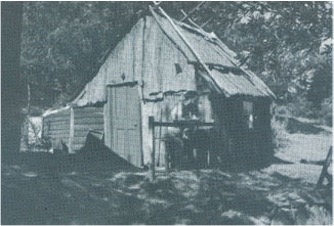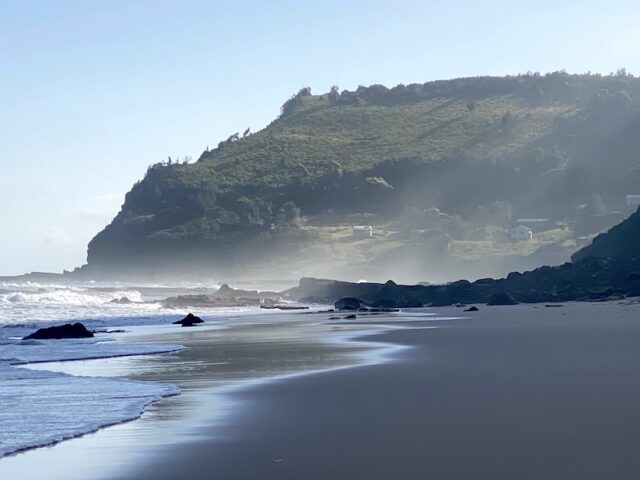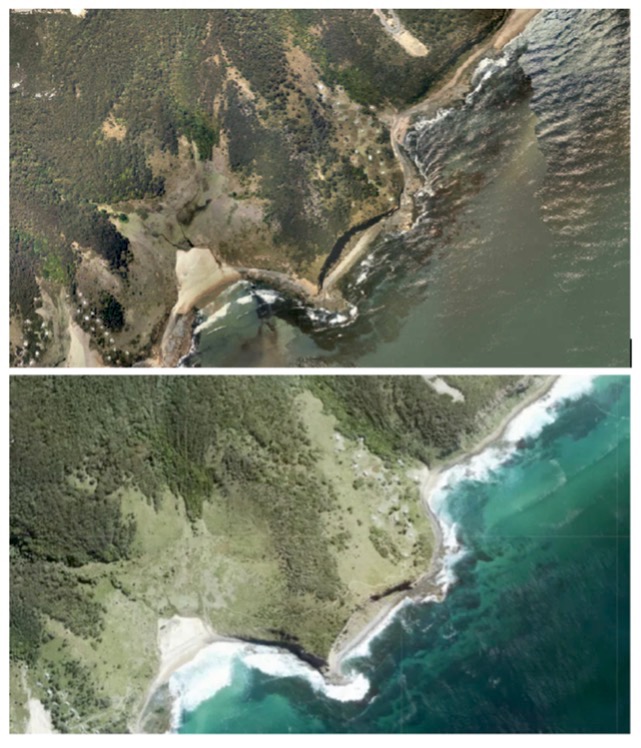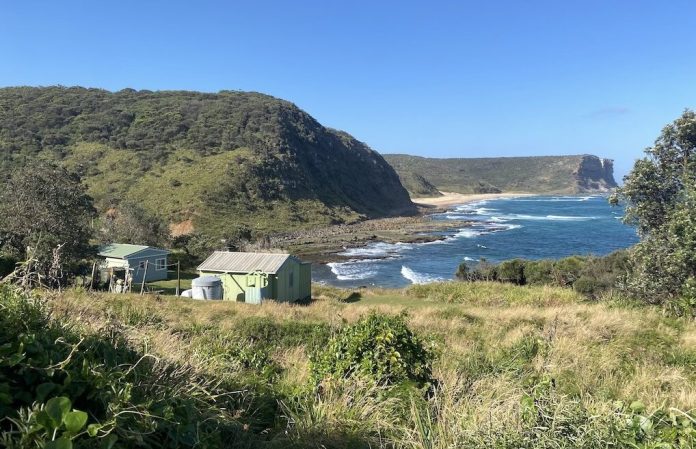Beaches broken by rolling hillsides form the coastal track, a distraction from sore wandering legs. Beach huts scatter through the grassy hills like a scene from an Enid Blyton mystery book. As a curious, growing child, I would ask my mum how they got there as there were no roads, and the same response would follow: they were built during the great depression. This explanation sprouted images of tired worker families huddling around a fire, while waves outside thrashed against the winds of a terrible storm. As I grew older however, I realised my imagination was no more a valid source than my mother’s explanation, and my curiosity for the true story grew. My romantic images were slowly strangled by the weeds that plagued these hillsides. Pursuing a career in ecology made me notice the strong correlation between built huts and invasive species rarely seen in other regions.
Hardworking Australians who struggled during the great depression built huts for their families, and foraged for food in the scrubs and raging oceans of the royal national parks (RNP). That is the story repeated by hikers on the origin of the huts that huddle in the headlands. A Georgia Holloway review on the importance of the huts acknowledges that many were formed during the Great Depression, but this is not the full story.

Old Tom, an Aboriginal stockman, built the first permanent hut between 1910-1912 (similar to the image here) but this shack is now inhabited by other families and there is little record of Aboriginal owners elsewhere.
Hut development continued after the Great Depression. In an interview with National Geographic, Billy Burns describes the origin of his shack. “My father first built a shack here after the war, as did a lot of other people.” Leaning shirtless against a stone hut he reminisces about holidays in the huts, Christmas and his father surfing and spearfishing. The article claims “some houses are more modern” but this overlooks the fact most huts have been renovated or rebuilt for use as holiday homes.
A few years ago, hiking along Garie Beach, I came across a man with a wheelbarrow, carrying food and water from the carpark along the track. Curious about these huts, I asked him how they were used. He put down the wheelbarrow. “We bring our families and friends to them and explore the coast,” he replied. ”The community that has formed among the huts and hills is what’s unique.”

Legal battles to list these huts under the NSW State Heritage Register in 2012 led to the creation of the RNP Coastal Cabins Protection League, dedicated to fighting demolition threats from the National Parks and Wildlife Services. This group has now surpassed its goal for mere survival to become a supportive source of community strength. Asked how repairs were done, the man with the wheelbarrow said: “Sometimes we get a helicopter together… we work together on most of our repairs and make it easier for each other.” The adaptations to the geographical isolation is unique, both from a heritage and an ecological perspective.
Historical communities fought against isolation and a naturally harsh environment through forming communal hunting groups. More recent communities are fighting the threat of dilapidation and demolition by forming protection leagues and sharing expenses. This has created strong community bonds.
But the building of huts and communities have led to an increase in cleared vegetation. Access to huts by wheelbarrow or helicopter increases trampling and causes removal of native vegetation, an impact that can be seen through satellite images (below). Removal of vegetation allows new species to dominate the ecosystem, in particular invasive species that are more resilient to human impacts.

Invasive deer, elegant intruders in the Royal National Park, have accumulated around the heritage huts. Deer and fawns meander up the thick grassy slopes and peer through eucalyptus forests. The prints of hooves and hikers’ shoes run across beaches and mud, encouraging the invasive succulent Mother of Millions, to infest these hills. Where no native plants can survive the stress of deer and humans, this succulent plant native to Madagascar forms carpets of leaves, growing wherever it falls. Umbels that release thousands of seeds rise, peeking between the native Lomandra tufts, dotting hillsides with colour.
The ecosystems that are forming spread quickly and are highly resilient to human intervention. Currently RNP’s coast contains a diverse gradient of ecosystems that have formed from millions of years of subtle adaptations. Leaving the depths of the palm jungle and walking into the blindingly bright, windy grassland, is unique to the Royal National Park coast, with its Eucalypt forests filled with the scent of wildflowers and the buzzing of native Australian bees. The new ecosystem, with its Lomandra tufts, peering deer and Mother of Millions, has the potential to overwhelm the long-established native ecosystems.
The impacts of these settlements on the natural environment have created concern within the hut community and the public. Hut dwellers actively participate with bush regeneration and Landcare volunteers spending mornings labouring, building fences or pulling weeds, and afternoons sharing stories and eating together. They are slowly learning how to intertwine heritage and environment, so they can thrive together.
As we grow older, we learn that the world is not as simple or as romantic as the books we read lead us to believe; I feel that the questions I ask now are as naïve as those I asked my mother. I have found that the communities within these valleys, ecological and human, can both damage and support each other. But the dramatically changing landscape in the Royal National Park, begs the question: “How sustainable is the current management of natural and human heritage within our Royal National Parks?”


